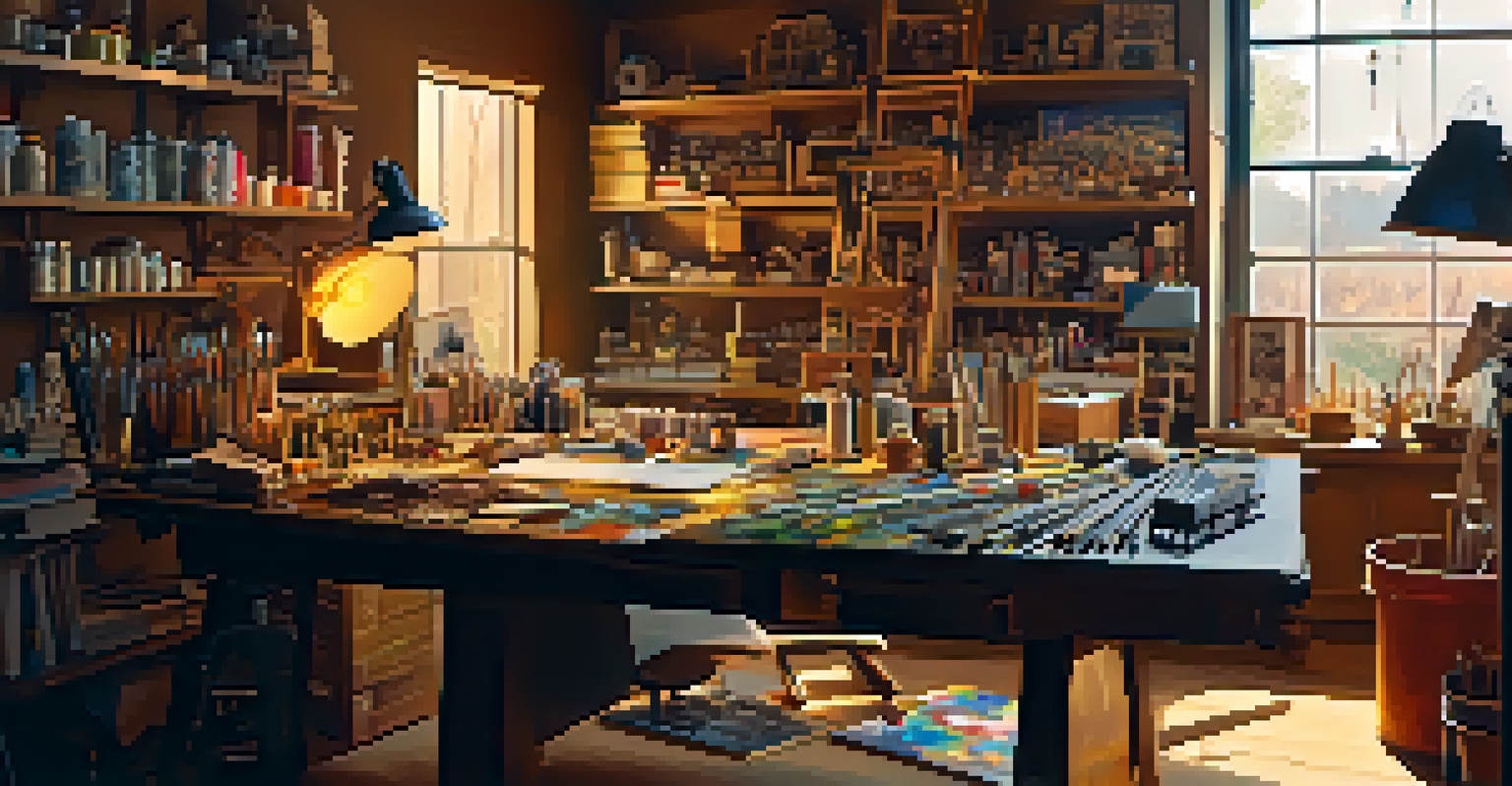The Role of Special Effects in Film Technology Evolution

Understanding Special Effects: A Brief Overview
Special effects, often referred to as SFX, play a pivotal role in filmmaking. They encompass techniques used to create illusions that enhance storytelling by adding visual elements that are not achievable through traditional filmmaking. From practical effects like miniatures and pyrotechnics to digital wizardry such as CGI, these techniques have transformed how we experience movies.
Special effects are a way to tell a story visually, and they can make a movie feel like a real experience.
Throughout history, filmmakers have pushed the boundaries of creativity, often relying on special effects to bring fantastical visions to life. For instance, the use of stop-motion animation in classics like 'King Kong' set the stage for more sophisticated effects. As technology grew, so did the complexity and realism of these effects, changing the landscape of cinema forever.
In today’s world, special effects are not just an afterthought; they are integral to the filmmaking process. Filmmakers now integrate SFX from the pre-production stage, allowing for a seamless blend of reality and imagination that captivates audiences. This evolution highlights the importance of special effects in enhancing narrative depth and emotional engagement.
The Evolution of Practical Effects in Early Cinema
In the early days of cinema, filmmakers relied heavily on practical effects to create thrilling spectacles. Techniques such as forced perspective, matte painting, and animatronics were common as directors sought to craft visually stunning scenes. For instance, the iconic train scene in 'The Great Train Robbery' (1903) used innovative camera angles to create a sense of motion and realism.

As technology advanced, so did the methods of creating practical effects. The invention of techniques like blue screen and rear projection allowed for more complex compositions, enabling filmmakers to blend real footage with imaginative landscapes. These advancements not only enhanced visual storytelling but also set a foundation for the future of special effects.
Special Effects Enhance Storytelling
Special effects are essential in filmmaking, adding visual elements that enrich narratives and engage viewers.
However, practical effects also faced challenges, particularly as audiences began to crave more dynamic and thrilling experiences. This desire for realism led filmmakers to explore the potential of digital effects, paving the way for a new era in the film industry. The transition from practical to digital was gradual, but it marked a significant turning point in the evolution of film technology.
The Rise of CGI: A Game Changer in Filmmaking
The introduction of computer-generated imagery (CGI) in the 1990s revolutionized the film industry. Films like 'Jurassic Park' showcased the power of CGI, bringing dinosaurs to life in a way that was previously unimaginable. This groundbreaking technology not only enhanced visual realism but also expanded the scope of storytelling in cinema.
The magic of cinema is not just in the stories we tell, but in the way we tell them through innovative techniques.
CGI allowed filmmakers to create elaborate worlds and characters that would have been impossible to achieve with practical effects alone. The ability to generate lifelike creatures and environments opened new doors for genres such as fantasy and science fiction, attracting audiences who craved immersive experiences. As a result, CGI quickly became a staple in modern filmmaking.
However, the rise of CGI also sparked debates about the balance between digital and practical effects. While CGI offers unparalleled possibilities, many filmmakers still value the authenticity of practical effects. This ongoing dialogue continues to shape the way special effects are approached, reminding us that both techniques have their place in the art of storytelling.
Blending Practical and Digital: The Best of Both Worlds
In recent years, filmmakers have embraced a hybrid approach, blending practical effects with CGI to create stunning visuals. This combination allows directors to leverage the tangible nature of practical effects while enhancing them with digital elements. For example, the 'Mad Max: Fury Road' (2015) utilized real stunts and practical vehicles, complemented by CGI to enhance the chaotic action sequences.
This fusion not only elevates the visual appeal of films but also maintains a sense of realism that resonates with audiences. By grounding special effects in reality, filmmakers can evoke genuine emotions, making the fantastical elements all the more impactful. This approach serves as a reminder that while technology evolves, the essence of storytelling remains unchanged.
Evolution from Practical to Digital
The transition from practical effects to CGI has transformed filmmaking, allowing for more complex and immersive storytelling.
Moreover, this synergy between practical and digital effects highlights the creativity and innovation within the film industry. Directors, visual effects artists, and practical effects teams are now collaborating more than ever, pushing the boundaries of what's possible. This cooperative spirit fosters an environment where new ideas flourish, ensuring that the art of filmmaking continues to evolve.
The Role of Special Effects in Audience Engagement
Special effects play a crucial role in capturing and maintaining audience engagement. They create a sense of wonder and excitement that can transport viewers into different worlds. Whether it's a breathtaking explosion or a stunning fantasy landscape, these visual elements stir emotions and draw viewers deeper into the narrative.
The effectiveness of special effects lies in their ability to evoke reactions. A well-executed effect can amplify tension, enhance humor, or even provide moments of awe. For example, the emotional weight of a character's journey can be heightened by the visual spectacle around them, allowing the audience to connect more profoundly with the story.
Furthermore, special effects often become iconic elements of a film, leaving a lasting impression long after the credits roll. Consider the swirling colors of 'Inception' or the stunning visuals of 'Avatar'; these elements not only define the films but also contribute to their cultural impact. In this way, special effects are not just about aesthetics; they are integral to the storytelling experience.
Future Trends in Special Effects Technology
As technology continues to advance, the future of special effects looks promising. Innovations like virtual reality (VR) and augmented reality (AR) are beginning to influence how stories are told in film. These technologies allow for immersive experiences that place viewers directly within the action, redefining traditional storytelling.
Additionally, artificial intelligence (AI) is making its mark on the industry by streamlining the production process and enhancing visual effects. AI-driven tools can analyze footage, generate realistic effects, and even assist in post-production, making it easier for filmmakers to realize their creative visions. This not only saves time but also opens new avenues for experimentation.
Future Trends: VR and AI Innovations
Emerging technologies like virtual reality and artificial intelligence are set to redefine the cinematic experience and storytelling techniques.
Moreover, the rise of independent filmmakers equipped with advanced technology means that creativity is no longer limited to big-budget productions. With tools like affordable CGI software and high-quality cameras, aspiring filmmakers can experiment with special effects in ways that were previously unattainable. This democratization of technology promises to unleash a wave of fresh ideas and storytelling styles in the years to come.
Conclusion: The Enduring Impact of Special Effects on Film
In summary, the role of special effects in the evolution of film technology cannot be overstated. From practical effects in early cinema to the sophisticated CGI of today, special effects have continually shaped the way stories are told on screen. They enhance visual storytelling, engage audiences, and push the boundaries of creativity.
As filmmakers explore new technologies and techniques, the future of special effects holds exciting possibilities. The blend of practical and digital effects, along with emerging innovations like VR and AI, will continue to redefine the cinematic experience. This evolving landscape serves as a reminder of the importance of adaptability and imagination in the art of filmmaking.

Ultimately, special effects are more than just visual spectacles; they are integral to the storytelling process. As we look ahead, it's clear that the magic of special effects will remain a cornerstone of cinema, captivating audiences and inspiring future generations of filmmakers.